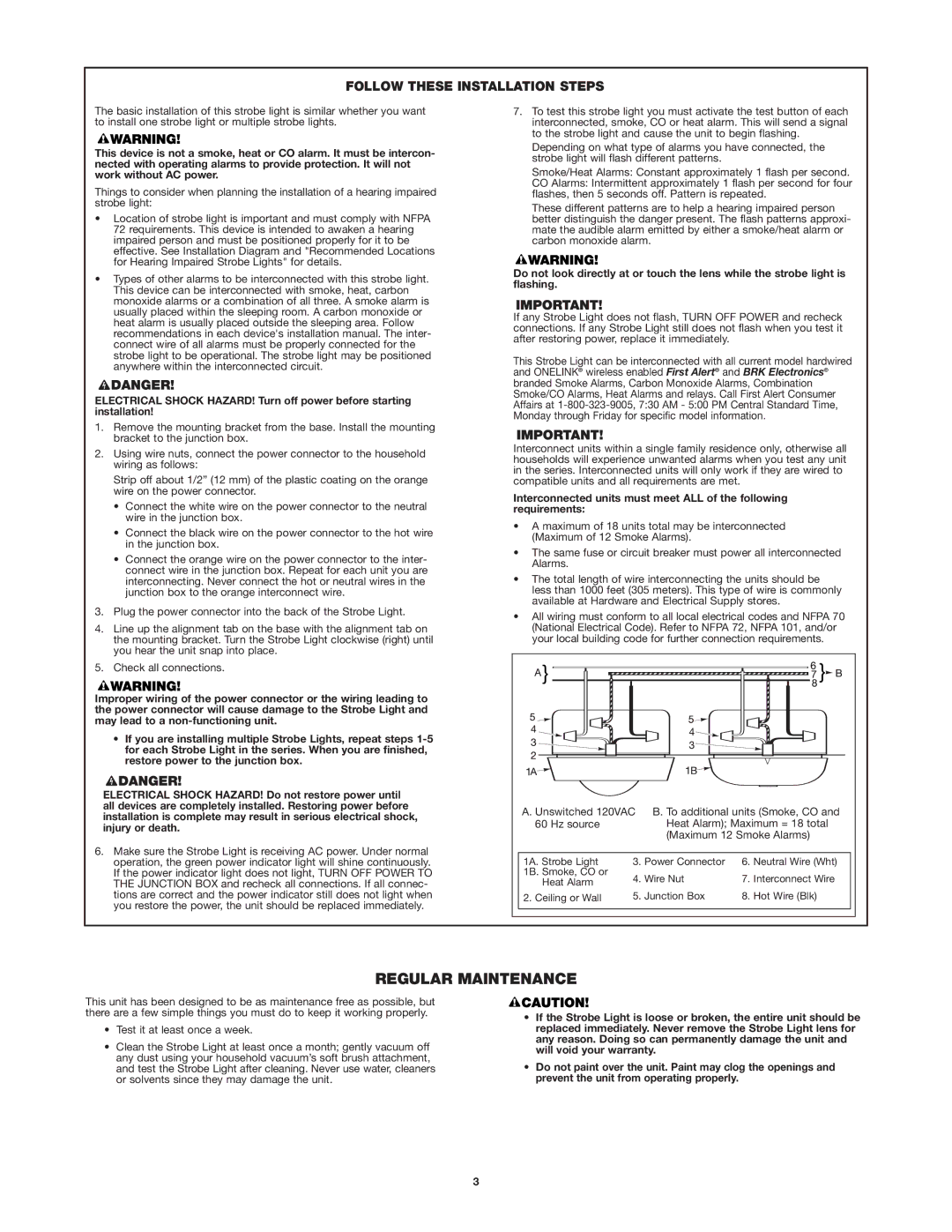The basic installation of this strobe light is similar whether you want to install one strobe light or multiple strobe lights.
This device is not a smoke, heat or CO alarm. It must be intercon- nected with operating alarms to provide protection. It will not work without AC power.
Things to consider when planning the installation of a hearing impaired strobe light:
•Location of strobe light is important and must comply with NFPA 72 requirements. This device is intended to awaken a hearing impaired person and must be positioned properly for it to be effective. See Installation Diagram and "Recommended Locations for Hearing Impaired Strobe Lights" for details.
•Types of other alarms to be interconnected with this strobe light. This device can be interconnected with smoke, heat, carbon monoxide alarms or a combination of all three. A smoke alarm is usually placed within the sleeping room. A carbon monoxide or heat alarm is usually placed outside the sleeping area. Follow recommendations in each device's installation manual. The inter- connect wire of all alarms must be properly connected for the strobe light to be operational. The strobe light may be positioned anywhere within the interconnected circuit.
ELECTRICAL SHOCK HAZARD! Turn off power before starting installation!
1.Remove the mounting bracket from the base. Install the mounting bracket to the junction box.
2.Using wire nuts, connect the power connector to the household wiring as follows:
Strip off about 1/2” (12 mm) of the plastic coating on the orange wire on the power connector.
•Connect the white wire on the power connector to the neutral wire in the junction box.
•Connect the black wire on the power connector to the hot wire in the junction box.
•Connect the orange wire on the power connector to the inter- connect wire in the junction box. Repeat for each unit you are interconnecting. Never connect the hot or neutral wires in the junction box to the orange interconnect wire.
3.Plug the power connector into the back of the Strobe Light.
4.Line up the alignment tab on the base with the alignment tab on the mounting bracket. Turn the Strobe Light clockwise (right) until you hear the unit snap into place.
5.Check all connections.
Improper wiring of the power connector or the wiring leading to the power connector will cause damage to the Strobe Light and may lead to a non-functioning unit.
•If you are installing multiple Strobe Lights, repeat steps 1-5 for each Strobe Light in the series. When you are finished, restore power to the junction box.
ELECTRICAL SHOCK HAZARD! Do not restore power until all devices are completely installed. Restoring power before installation is complete may result in serious electrical shock, injury or death.
6.Make sure the Strobe Light is receiving AC power. Under normal operation, the green power indicator light will shine continuously. If the power indicator light does not light, TURN OFF POWER TO THE JUNCTION BOX and recheck all connections. If all connec- tions are correct and the power indicator still does not light when you restore the power, the unit should be replaced immediately.
7.To test this strobe light you must activate the test button of each interconnected, smoke, CO or heat alarm. This will send a signal to the strobe light and cause the unit to begin flashing.
Depending on what type of alarms you have connected, the strobe light will flash different patterns.
Smoke/Heat Alarms: Constant approximately 1 flash per second.
CO Alarms: Intermittent approximately 1 flash per second for four flashes, then 5 seconds off. Pattern is repeated.
These different patterns are to help a hearing impaired person better distinguish the danger present. The flash patterns approxi- mate the audible alarm emitted by either a smoke/heat alarm or carbon monoxide alarm.
Do not look directly at or touch the lens while the strobe light is flashing.
If any Strobe Light does not flash, TURN OFF POWER and recheck connections. If any Strobe Light still does not flash when you test it after restoring power, replace it immediately.
This Strobe Light can be interconnected with all current model hardwired and ONELINK® wireless enabled First Alert® and BRK Electronics® branded Smoke Alarms, Carbon Monoxide Alarms, Combination Smoke/CO Alarms, Heat Alarms and relays. Call First Alert Consumer Affairs at 1-800-323-9005, 7:30 AM - 5:00 PM Central Standard Time, Monday through Friday for specific model information.
Interconnect units within a single family residence only, otherwise all households will experience unwanted alarms when you test any unit in the series. Interconnected units will only work if they are wired to compatible units and all requirements are met.
Interconnected units must meet ALL of the following requirements:
•A maximum of 18 units total may be interconnected (Maximum of 12 Smoke Alarms).
•The same fuse or circuit breaker must power all interconnected Alarms.
•The total length of wire interconnecting the units should be less than 1000 feet (305 meters). This type of wire is commonly available at Hardware and Electrical Supply stores.
•All wiring must conform to all local electrical codes and NFPA 70 (National Electrical Code). Refer to NFPA 72, NFPA 101, and/or your local building code for further connection requirements.
 }
} 

 }
}
A. Unswitched 120VAC B. To additional units (Smoke, CO and
60 Hz sourceHeat Alarm); Maximum = 18 total (Maximum 12 Smoke Alarms)
| 1A. Strobe Light | 3. | Power Connector | 6. | Neutral Wire (Wht) |
| 1B. Smoke, CO or | 4. | Wire Nut | 7. | Interconnect Wire |
| Heat Alarm |
| | | | |
| 2. Ceiling or Wall | 5. | Junction Box | 8. | Hot Wire (Blk) |
| | | | | |

